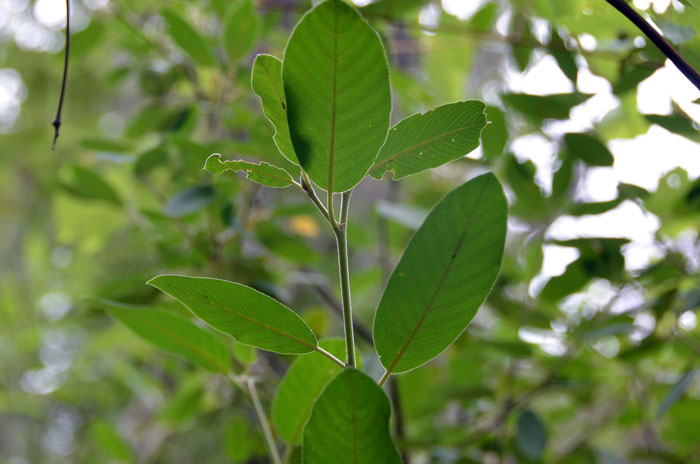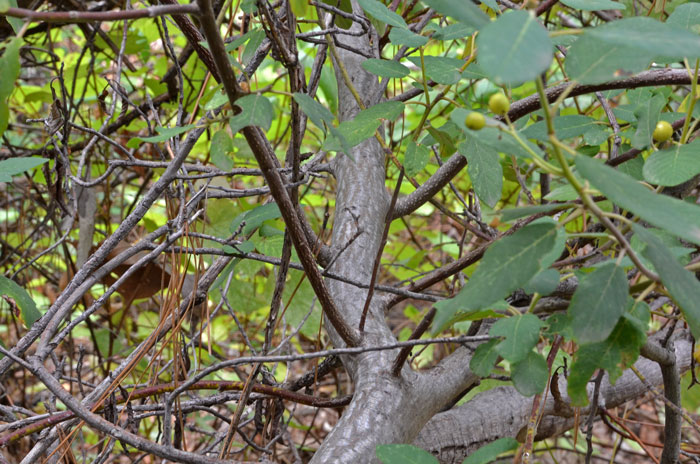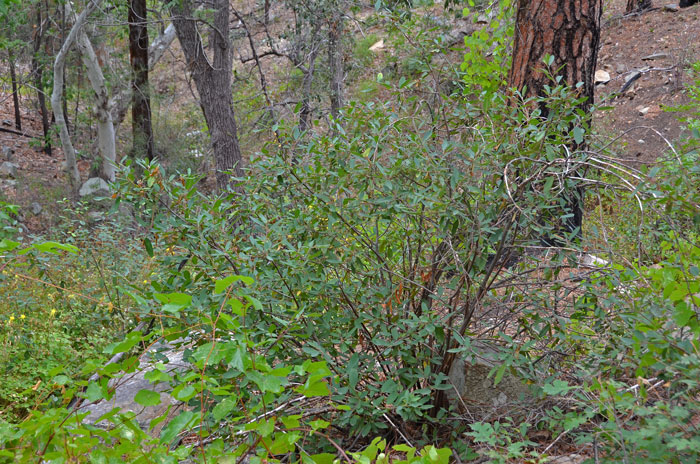Frangula californica, California Buckthorn




Scientific Name: Frangula californica
Common Name: California Buckthorn
Also Called: Buckthorn, California Coffeeberry, Coffee-berry, Pigeon-berry (Spanish: Hierba de Oso, Cacachila)
Family: Rhamnaceae or Buckthorn Family
Synonyms: (Rhamnus californica, Rhamnus californica subsp. crassifolia, Rhamnus californica subsp. cuspidata, Rhamnus californica subsp. occidentalis, Rhamnus californica var. occidentalis)
Status: Native
Duration: Perennial
Size: Up to 18 feet more or less but usually much smaller.
Growth Form: Shrub or tree; stems gray to red; bark gray or brown; twigs glabrous to finely hairy (tomentose), no scales.
Leaves: Green, evergreen; with petioles, leaf shape variable, ovate to elliptic; leaves thick; whitish; whitish-tomentose beneath; margins serrate to entire, rolled under (revolute); both surfaces mostly glabrous.
Flower Color: Yellowish-tan; flowers in clusters of 5 to 60, pedicels up to ¾ inch; bisexual, 5 petal and 5 sepals; fruit black.
Flowering Season: May and June; April to May in Texas.
Elevation: 3,500 to 6,500 feet.
Habitat Preferences: Common in chaparral, and open coniferous forests; coastal sage scrub chaparral and woodlands in California.
Recorded Range: Frangula californica is found in the southwest and far western United States in AZ, CA, NM, NV, OR. Highest populations occur in Arizona and California. In Arizona it is found throughout most of the state but few or no records in the northeast (Apache and Navajo counties) and southwest (Yuma and LaPaz counties) parts of the state. It is also native to Baja California and northwest Mexico.
In Arizona, it is found throughout most of the state with few or no records in the northeast (Apache and Navajo counties) and southwest (Yuma and LaPaz counties) parts of the state.
North America & US County Distribution Map for Frangula californica.
U.S. Weed Information: No information available.
Invasive/Noxious Weed Information: No information available.
Wetland Indicator: No information available.
Threatened/Endangered Information: No information available.
In Arizona there are 2 species of Frangula, in California and Nevada teach have 3 species, New Mexico and Texas have 2 species each, Utah has1 species. All data is approximate and subject to taxonomic changes.
There are 6 varieties in Frangula californica;
Frangula californica subsp. californica, California Buckthorn (CA);
Frangula californica subsp. crassifolia, California Buckthorn (CA);
Frangula californica subsp. cuspidata, California Buckthorn (CA);
Frangula californica subsp. occidentalis, California Buckthorn (CA, OR);
Frangula californica subsp. tomentella, California Buckthorn (CA);
Frangula californica subsp. ursina, California Buckthorn (AZ, CA, NV, UT);
Comments: California Buckthorn has special value to native bees. The type (Rhamnus californica) is from Chiricahua Mountains, Cochise, County, Arizona (Blumer 1290 in part)
Frangula californica has been used for a wide variety of purposes by North American indigenous peoples.
Neeshenam Drug, Toothache Remedy Heated root held in the mouth for toothaches.
Costanoan Drug, Cathartic Decoction of inner bark used as a purgative.
Kawaiisu Drug, Antidote Crushed berries used to counteract poisoning.
Mahuna Drug, Cathartic Powdered bark used as a cathartic for constipation.
Mendocino Indian Drug, Kidney Aid Bark used for kidney troubles.
Paiute Food, Fruit Fruit eaten fresh.
Cahuilla Drug, Laxative Infusion of berries taken as a laxative.
See ethno-botanical uses at Native American Ethnobotany, University of Michigan, Dearborn.

